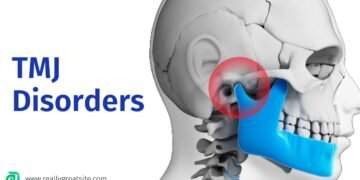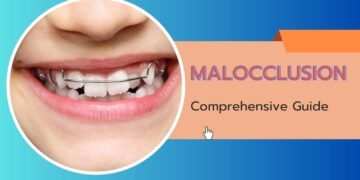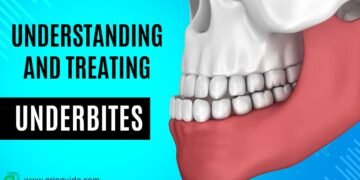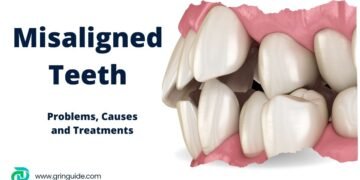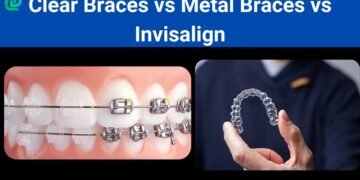Table of Contents
Introduction
An overbite, it’s also called a “deep bite” or a “closed bite.” a common dental condition, occurs when the upper front teeth significantly overlap the lower front teeth. This overlap can be classified into two primary categories: dental and skeletal overbites. A dental overbite is primarily due to the misalignment of the teeth, whereas a skeletal overbite results from discrepancies in jawbone development. Understanding these distinctions is crucial for determining the most effective treatment plan.
Overbites can range from minor to severe and are often measured in terms of the percentage of overlap. Typically, a normal overbite should present with a 10-20% overlap. However, when the overlap exceeds this range, it can lead to various dental health issues. These issues may include difficulties in biting and chewing, speech impediments, and increased risk of tooth wear and damage.
Research indicates that overbite is prevalent in both children and adults, affecting a significant portion of the population. According to the American Association of Orthodontists, approximately 70% of dental patients have some form of an overbite. Addressing overbites is not only important for aesthetic reasons but also for maintaining overall oral health. Untreated overbites can lead to temporomandibular joint disorders (TMD), periodontal disease, and even digestive problems due to improper chewing.
Recognizing the type and severity of an overbite early on can significantly impact the treatment approach and outcomes. Dental professionals often recommend orthodontic interventions, such as braces, to correct overbites and realign the teeth and jaw. The process of addressing an overbite typically involves a comprehensive evaluation by an orthodontist, who will develop a tailored treatment plan to achieve optimal results. By understanding what overbites are and their implications, individuals can make informed decisions about their dental health and seek appropriate care when necessary.
Causes
Overbites, a common orthodontic issue, arise from various factors that can be categorized broadly into genetic and behavioral influences. Understanding these root causes is essential for both prevention and treatment.
1. Genetic Factors
Genetics play a significant role in the development of overbites. If one or both parents have an overbite, there is a higher likelihood that their children will inherit this dental condition. Genetic predisposition can influence the size and shape of the jaw, the alignment of teeth, and the overall dental structure. For instance, a naturally small jaw may not provide adequate space for teeth, leading to overcrowding and subsequently, an overbite.
2. Childhood Habits
Childhood habits, particularly those formed in early developmental stages, can contribute considerably to the formation of overbites. Thumb sucking, prolonged use of pacifiers, and even bottle feeding beyond infancy are common practices that exert pressure on the upper front teeth, pushing them forward. This forward pressure disrupts the normal alignment, resulting in an overbite. The longer these habits persist, the more pronounced the overbite can become.

3. Jaw Misalignment and Missing Teeth
Jaw misalignment, also known as malocclusion, is another significant cause of overbites. When the upper and lower jaws do not align properly, it can push the upper teeth outward, causing an overbite. This misalignment can be due to developmental issues or trauma to the jaw. Additionally, missing teeth can also lead to overbites. When a tooth is lost and not replaced, the neighboring teeth may shift into the empty space, causing misalignment and potentially resulting in an overbite.
Recognizing these causes is crucial for effective treatment and prevention of overbites. By addressing genetic predispositions, curbing detrimental childhood habits, and correcting jaw misalignments or replacing missing teeth, one can manage and mitigate the impact of overbites effectively.
Identifying the Need for Braces
Determining whether an overbite requires braces involves a careful assessment of symptoms and signs that indicate the necessity for orthodontic intervention. Overbites, characterized by the upper teeth significantly overlapping the lower teeth, can manifest through various functional and aesthetic issues.
One of the primary indicators that braces may be needed is difficulty in biting and chewing. Individuals with significant overbites often find it challenging to properly align their teeth to break down food, leading to inefficient chewing and potential digestive issues. This difficulty can also contribute to uneven wear on the teeth, exacerbating dental health concerns over time.
Speech impediments are another critical symptom of an overbite. Misalignment of the teeth can affect the way sounds are produced, leading to speech difficulties such as lisping or unclear articulation. These impediments can impact communication skills and overall confidence, particularly in social and professional settings.
Aesthetic concerns are also a common reason for seeking orthodontic treatment for overbites. The noticeable overlap of teeth can affect the appearance of one’s smile and facial profile, leading to self-consciousness and reduced self-esteem. Correcting an overbite with braces not only improves dental function but also enhances facial aesthetics, contributing to a more balanced and pleasing appearance.
The role of a dentist or orthodontist is crucial in diagnosing an overbite and determining the best course of action. During a routine dental examination, a dentist may identify signs of an overbite and refer the patient to an orthodontist for a more specialized assessment. The orthodontist will conduct a thorough evaluation, including X-rays and dental impressions, to understand the severity of the overbite and recommend an appropriate treatment plan.
In summary, recognizing the need for braces to correct an overbite involves understanding the functional and aesthetic issues it presents. Difficulty in biting and chewing, speech impediments, and concerns about appearance are key indicators that orthodontic intervention may be necessary. Consulting with a dental professional is essential to obtain a proper diagnosis and explore effective treatment options.
Braces Types to Correct Overbite
When it comes to correcting overbites, various types of braces are available, each presenting unique advantages and potential drawbacks. Understanding these options can help individuals make informed decisions about their treatment plan.
1. Traditional Metal Braces
Traditional metal braces are the most common and widely recognized form of orthodontic treatment. These braces use metal brackets and wires to gradually move teeth into their correct positions. The primary advantage of metal braces is their effectiveness in treating severe overbites. They are highly durable and can correct a wide range of dental issues. However, their noticeable appearance and potential discomfort are considered drawbacks by many patients.
2. Ceramic Braces
Ceramic braces function similarly to metal braces but use clear or tooth-colored brackets, making them less conspicuous. These braces are a popular choice for individuals seeking a more aesthetically pleasing option while still benefiting from the effectiveness of traditional braces. While ceramic braces are less noticeable, they can be more fragile and may require more diligent oral hygiene to avoid staining.

3. Lingual Braces
Lingual braces are placed on the inside surface of the teeth, making them virtually invisible from the outside. This makes them an attractive option for those concerned about the appearance of braces. They are just as effective as traditional braces in correcting overbites. However, lingual braces can be more challenging to clean, may cause initial discomfort to the tongue, and typically require a higher level of expertise to install, which can increase treatment costs.
4. Clear Aligners
Clear aligners, such as Invisalign, offer a modern and discreet solution for overbite correction. These removable aligners are custom-made to fit snugly over the teeth and are replaced every few weeks to gradually shift teeth into place. Clear aligners are nearly invisible and can be removed for eating and cleaning, providing convenience and comfort. However, they may not be suitable for severe overbites and require significant discipline to wear the aligners for the recommended 20-22 hours per day.
Each type of braces offers distinct benefits and potential limitations. The choice of treatment depends on individual preferences, the severity of the overbite, and professional recommendations from an orthodontist.
The Treatment Process: What to Expect
Correcting an overbite with braces involves a structured treatment process that begins with an initial consultation. During this initial visit, an orthodontist evaluates the severity of the overbite, takes X-rays, and discusses the most suitable treatment plan. This consultation is crucial for setting realistic expectations and understanding the timeline and costs involved in the treatment.
Once a treatment plan is agreed upon, the next step is the fitting of the braces. The orthodontist carefully attaches brackets to the teeth, threading an archwire through them. This wire exerts the necessary force to gradually move the teeth into the desired position. The fitting process typically takes about one to two hours and may cause some initial discomfort, but this is a normal part of the adjustment period.
Following the placement of braces, patients will need to attend regular adjustment appointments, usually every 4 to 6 weeks. During these visits, the orthodontist will tighten the arch wire and sometimes replace the rubber bands or other components. These adjustments are essential for the continuous correction of the overbite. While some discomfort is common after each adjustment, it generally subsides within a few days.
The duration of treatment for overbites varies based on several factors, including the severity of the deep bite, the patient’s age, and how well they follow the orthodontist’s instructions, such as wearing rubber bands or other appliances. On average, treatment can last anywhere from 18 months to 3 years. Consistent care and adherence to the orthodontist’s guidelines can significantly impact the treatment’s effectiveness and duration.
Throughout the treatment process, patients may experience mild to moderate discomfort, particularly after adjustments. However, this discomfort is typically manageable with over-the-counter pain relievers and a soft food diet immediately following adjustments. Overall, understanding the treatment process can help patients better prepare for their journey to correcting a deep bite.
Before and After: Real-Life Transformations
Real-life transformations serve as compelling evidence of the efficacy of braces in correcting overbites. By examining a series of before-and-after cases, we can better understand how orthodontic treatment can dramatically improve dental alignment and overall facial aesthetics. These examples highlight the tangible benefits of undergoing such a procedure, offering a glimpse into the positive changes that patients experience.

Consider the case of Sarah, who struggled with a severe deep bite that affected her confidence and oral health. Before treatment, her upper teeth significantly overlapped her lower teeth, causing speech difficulties and discomfort. After 18 months of wearing braces, Sarah’s deep bite was corrected, resulting in a balanced bite and a more harmonious smile. She recalls,
The transformation was incredible. I can speak more clearly, and I feel much more confident in my appearance.
Another notable example is Mark, whose mild deep bite led to chronic jaw pain and headaches. Initially apprehensive about getting braces, Mark decided to proceed after consulting with his orthodontist. Over the course of a year, his teeth gradually moved into their correct positions, alleviating his symptoms. Post-treatment, Mark shares,
I had no idea how much my deep bite was affecting my daily life until it was corrected. The braces not only fixed my bite but also improved my quality of life.
Visual evidence further underscores these transformations. Before-and-after photos vividly illustrate the changes in dental structure and facial symmetry. These images, coupled with patient testimonials, provide compelling proof of the benefits of braces in treating overbites. They also offer reassurance to those considering orthodontic treatment, showcasing the potential for significant improvements.
Ultimately, these real-life stories and visual examples demonstrate that braces are a powerful tool in correcting overbites. They highlight the importance of orthodontic intervention in achieving both functional and aesthetic outcomes, underscoring the life-changing impact of such treatments.
Post-Treatment Care
Once the braces are removed, the journey towards correcting an overbite doesn’t end. Post-treatment care and maintenance are crucial to ensure the results are long-lasting and to prevent any relapse. A primary component of this phase is the use of retainers. Retainers are custom-made devices that help keep your teeth in their new positions. Depending on the severity of the deep bite and the orthodontist’s recommendations, retainers may be worn full-time initially and gradually reduced to only nighttime use.
- Maintaining oral hygiene is another essential aspect of post-treatment care. Brushing and flossing should be done diligently to prevent any build-up of plaque and tartar, which could affect the alignment of your teeth. Using fluoride toothpaste and an antiseptic mouthwash can further help in keeping your teeth and gums healthy. Regular cleanings and check-ups with your dentist will ensure that any potential issues are addressed promptly, keeping your smile in optimal condition.
- Regular dental check-ups are indispensable, even after the braces are off. These visits allow the orthodontist to monitor the stability of the deep bite correction and make adjustments to the retainers if necessary. It’s recommended to schedule follow-up appointments every few months initially, and then at least once a year as your teeth settle into their new positions. Your orthodontist may also provide specific exercises to strengthen the jaw muscles and support the new alignment.
- Lifestyle adjustments can also play a significant role in maintaining the results achieved through braces. Avoiding hard and sticky foods that can damage your retainers or shift your teeth is advisable. Additionally, breaking habits like nail-biting, chewing on pens, or using your teeth as tools can prevent undue stress on your teeth and jaw.
By diligently following these post-treatment guidelines, you can help ensure that the correction of your deep bite is maintained for years to come, allowing you to enjoy the benefits of a healthy, well-aligned smile.
Conclusion: The Benefits of Correcting Overbites
Throughout this blog post, we have delved into the multifaceted aspects of overbites, the causes, consequences, and the transformative power of braces in their correction. Addressing overbites is not merely a cosmetic endeavor; it encompasses significant health benefits, ranging from improved oral hygiene to alleviation of jaw pain and prevention of future dental complications.
One of the primary benefits of correcting overbites is the enhancement of overall dental health. Misaligned bites can lead to uneven wear of teeth, increasing the likelihood of tooth decay and gum disease. By aligning the teeth properly, braces help in distributing bite forces evenly, thereby reducing the risk of these dental issues.
Furthermore, correcting a deep bite can lead to significant improvements in speech and chewing efficiency. Overbites often cause speech impediments and difficulties in properly chewing food, which can impact nutrition and overall well-being. Braces work to align the teeth and jaw, facilitating clearer speech and more efficient eating habits.
From an aesthetic perspective, the correction of overbites through braces can significantly boost self-confidence. A well-aligned smile is often associated with positive social interactions and improved self-esteem. For many individuals, the transformation experienced before and after treatment with braces is profoundly life changing.
Lastly, addressing overbites early on can prevent more severe dental and skeletal issues later in life. Orthodontic treatment not only corrects existing problems but also mitigates the development of future complications, leading to long-term oral health benefits.
For those contemplating orthodontic treatment for their deep bite, it is essential to recognize the comprehensive benefits that braces can offer. The journey to a healthier, more confident smile is well worth the effort and commitment. Correcting a deep bite is an investment in your overall health and well-being, ensuring a lifetime of improved dental function and aesthetics.
FAQs
-
Can You Fix an Overbite?
Yes, an overbite can be corrected through various orthodontic treatments. Braces are the most common solution for fixing a deep bite. They work by gradually moving the teeth into proper alignment over time. In some cases, other orthodontic appliances like retainers or clear aligners may be used. For severe deep bite, surgical options might be considered to align the jaw properly.
-
Does Overbite Need Braces?
Braces are often recommended for correcting an overbite, especially in cases where the condition is significant. Braces help in aligning the teeth and jaw, reducing the risk of further dental issues such as tooth decay, gum disease, and jaw pain. However, the need for braces can vary depending on the severity of the overbite and the individual’s overall dental health.
-
Can an Overbite Correct Itself?
In some mild cases, an overbite may improve on its own, especially in children as they grow and their jaws develop. However, it is rare for a significant deep bite to correct itself without intervention. Consulting an orthodontist is the best way to determine the appropriate treatment plan for a deep bite.
-
What is an overbite caused by?
Several factors can lead to the development of an overbite. Genetics play a significant role, as the shape and size of a person’s jaw and teeth are often inherited. Other causes include prolonged thumb-sucking during childhood, extended use of a pacifier, and habits like nail-biting or pen-chewing. Additionally, missing teeth or teeth that are too large or small for the jaw can contribute to a deep bite.

